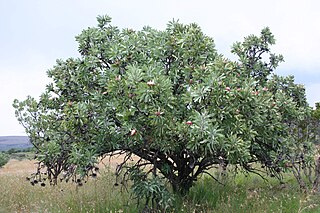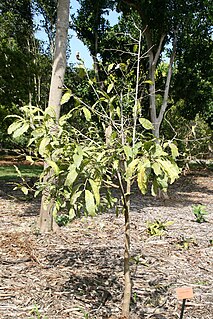
Strychnos is a genus of flowering plants, belonging to the family Loganiaceae. The genus includes about 100 accepted species of trees and lianas, and more than 200 that are as yet unresolved. The genus is widely distributed around the world's tropics and is noted for the presence of poisonous indole alkaloids in the roots, stems and leaves of various species. Among these alkaloids are the well-known and virulent poisons strychnine and curare.

Casuarina is a genus of 17 tree species in the family Casuarinaceae, native to Australia, the Indian subcontinent, southeast Asia, islands of the western Pacific Ocean, and eastern Africa. It was once treated as the sole genus in the family, but has been split into four genera.

Annona glabra is a tropical fruit tree in the family Annonaceae, in the same genus as the soursop and cherimoya. Common names include pond apple, alligator apple, swamp apple, corkwood, bobwood, and monkey apple. The tree is native to Florida in the United States, the Caribbean, Central and South America, and West Africa. It is common in the Everglades. The A. glabra tree is considered an invasive species in Sri Lanka and Australia. It grows in swamps, is tolerant of saltwater, and cannot grow in dry soil.

Viburnum lantana, the wayfarer or wayfaring tree, is a species of Viburnum, native to central, southern and western Europe, northwest Africa, and southwestern Asia. The vigorous deciduous European treelike shrub is common along waysides.

Sambucus nigra is a species complex of flowering plants in the family Adoxaceae native to most of Europe and North America. Common names include elder, elderberry, black elder, European elder, European elderberry, and European black elderberry. It grows in a variety of conditions including both wet and dry fertile soils, primarily in sunny locations. The plant is a very common feature of hedgerows and scrubland in Britain and northern Europe, but is also widely grown as an ornamental shrub or small tree. Both the flowers and the berries have a long tradition of culinary use, primarily for cordial and wine. The Latin specific epithet nigra means "black", and refers to the deeply dark colour of the berries.

Hakea laurina is shrub or small tree commonly known as kodjet or pin-cushion hakea and is endemic to Western Australia. The Noongar name for the plant is kodjet or kojet. It has red and cream conspicuous globular flowers and lance shaped leaves.

Schinus molle is an evergreen tree that grows to 15 meters. It is native to the Peruvian Andes. The bright pink fruits of Schinus molle are often sold as "pink peppercorns" although S. molle is unrelated to true pepper. The word molle in Schinus molle comes from mulli, the Quechua word for the tree. The tree is host to the pepper-tree moth, Bombycomorpha bifascia.

Protea caffra, native to South Africa, is a small tree or shrub which occurs in open or wooded grassland, usually on rocky ridges. Its leaves are leathery and hairless. The flower head is solitary or in clusters of 3 or 4 with the involucral bracts a pale red, pink or cream colour. The fruit is a densely hairy nut. The species is highly variable and has several subspecies.

Protea welwitschii is a species of shrub or small tree which belongs to the genus Protea, and which occurs in bushveld and different types of grassland.

Rhamnus cathartica, the European buckthorn, common buckthorn, purging buckthorn, or just buckthorn, is a species of small tree in the flowering plant family Rhamnaceae. It is native to Europe, northwest Africa and western Asia, from the central British Isles south to Morocco, and east to Kyrgyzstan. It was introduced to North America as an ornamental shrub in the early 19th century or perhaps before, and is now naturalized in the northern half of the continent, and is classified as an invasive plant in several US states and in Ontario, Canada.

Ziziphus mucronata, known as the buffalo thorn, is a species of tree in the family Rhamnaceae, native to southern Africa. It is deciduous and may grow up to 17 metres tall. It can survive in a variety of soil types, occurring in many habitats, mostly open woodlands, often on soils deposited by rivers, and grows frequently on termite mounds. Its Zulu name “umLahlankosi” alludes to its use as a grave marker for tribal chiefs, while the Afrikaans name “Blinkblaar-wag-'n-bietjie” alludes to the shiny light green leaves and the hooked thorns.

Syzygium guineense is a leafy forest tree of the family Myrtaceae, found in many parts of Africa both wild and domesticated. Both its fruits and leaves are edible; the pulp and the fruit skin are sucked and the seed discarded. It is sometimes called "waterberry", but this may also refer to other species of Syzygium.

Balanites aegyptiaca is a species of tree, classified as a member of either the Zygophyllaceae or the Balanitaceae. This tree is native to much of Africa and parts of the Middle East.

Balanites is an Afrotropical, Palearctic and Indomalayan genus of flowering plants in the caltrop family, Zygophyllaceae. The name Balanites derives from the Greek word for an acorn and refers to the fruit, it was coined by Alire Delile in 1813.
Balanites wilsoniana is a species of fruit-bearing tree from west and central Africa from the caltrop family (Zygophyllaceae).
Balanites angolensis, or Angolan green-thorn, is a species of tree from southern Africa, it is a member of the caltrop family, Zygophyllaceae.
Balanites pedicellaris, the small green-thorn or small torchwood is a small tree or shrub from Sub-Saharan Africa. It is a member of the caltrop family Zygophyllaceae.
Balanites rotundifolia, known in Swahili as Mbamba ngoma is a spiny bush or small tree from eastern Africa and southern Arabia. It is a member of the caltrop family, Zygophyllaceae.

Lecythis minor, the monkey-pot tree, is a small tree with toxic seeds that occurs in South America.














